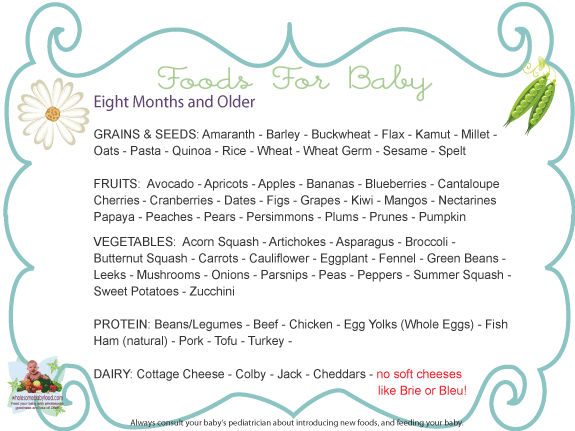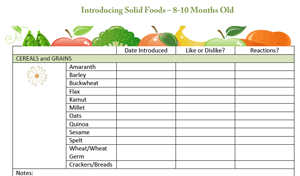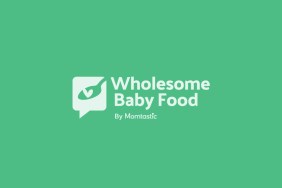Introducing Solid Foods to Your 8 – 10 Month Old Baby
“I’m moving on and I want to feed myself!”
Your 8-10 Month old baby might be crawling and trying to pull herself up. and she may not have a big interest in eating. As noted in the Is my Baby a Picky Eater page, your baby may suddenly begin to refuse to eat because she has more important things to do – like pull on the cat’s tail or munch the scrap of paper she just found.
At this stage, your little one may also start to Refuse to be Spoon Fed.
Bring on some spices (8 months old)
and softly mashed, or chopped into fine pieces, fruits, vegetables, meats, pasta and dairy such as yogurt and cheeses.
Pasta, veggies, and fruit should all be soft cooked and possibly mashed with a fork or masher. (Bananas need only be mashed.)
Meats and proteins such as egg yolk, should be cooked and pureed or chopped into small soft bits. If offering Tofu, you need not cook it first.
Remember, your baby will not have molars until sometime around the 12-18 month age range so all foods should be easily mashed between the gums.
How much will your 8 month – 10 month old baby eat?
Your 8 to 10 month old baby may seem to be starving herself at some point. Because you are likely offering her more finger food selections or thicker/chunkier foods, the amount of food eaten appears smaller.
At this stage, your baby may be eating 3 “meals” a day and possibly enjoying a snack or 2 in between.
There are some babies in this age range who will still be eating only 1 “meal” of solids so don’t feel pressured to have your baby eat 3 solid food meals per day. The important thing is to watch your baby’s hunger cues and and try to begin setting a schedule for 3 meals a day. Offer him a balanced array of foods – fruits, veggies, a protein & a grain if possible and ensure his nursing or formula feedings are adequate.
Visit the Baby Menu to see an idea of some meals for this age range.
What to Eat at 8 to 10 Months of Age?AGE/STAGE – 8 months – 10 months oldThe AAP recommends that an infant not be started on solid foods until after 6 months of age. Many pediatricians still start babies on solids around 4 months of age. This chart accommodates all ages and stages up to 12 months. CEREALSTry mixing together the grains that your baby has had without any reaction(s). Begin offering breads and muffins when baby has mastered mashing more textured foods. Pasta makes for great finger foods. FRUITSBegin making your own fruit combinations once baby has had several fruits without any reaction(s). Venture into Papaya and Melon Swirl. After 8 months old – you may wish to try offering raw ripe fruits. Soft cooked fruits make for great beginner Baby Finger Foods. VEGGIESSoft cooked veggies make for great beginner Baby Finger Foods. Try mixing up a veggie medley now. Add some grated cheese for extra temptation & yumminess. Saute or roast some onions or peppers to add to baby’s food or serve as finger foods. Make a Leek and Chicken Potato Mash. PROTEINOnce your baby has reached 8 months old, try an Egg Yolk Omelet – the perfect chance to slip in some veggies. DAIRYGet adventurous with Cheeses and Yogurts now. Soft Cheeses such as Brie pose health risks so hold off on those. Avocado mashed with a bit of cream cheese – YUM. |
Stages of Solid Foods – 8 months and older – Baby Let’s Eat!
8 Months – Give me it all!
Bring on some spices (8 months old) and the softly mashed, or chopped into fine pieces of fruits, vegetables, meats, pasta and dairy such as yogurt and cheeses.
![]() Click here for a printable “no ad” version of the complete solid food introduction chart
Click here for a printable “no ad” version of the complete solid food introduction chart
![]() New Breast-Fed Baby Growth Charts from the World Health Organisation – Reflecting Breast-Fed Babies Growth Patterns
New Breast-Fed Baby Growth Charts from the World Health Organisation – Reflecting Breast-Fed Babies Growth Patterns
The charts presented are general guidelines with solid baby foods that are age appropriate. They may seem somewhat conservative in nature compared to guidelines from other sources. We show age-ranges for different foods and we have researched and compiled these charts from various medical authorities such as private pediatricians, the AAP, the AAFP and the WHO. Feel free to print the chart and ask your Pediatrician about the listings and recommendations. Our visitors say their pediatricians are impressed with our Chart’s suitability and accuracy of listings.




